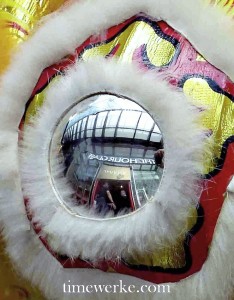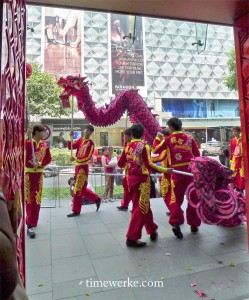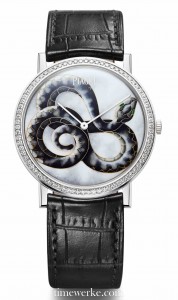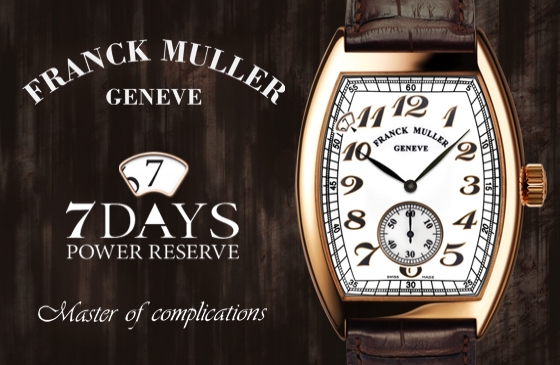
22 February 2013, 11.23am, lion heads ready for their festive Chinese Lunar New Year dance. Notice the circular polished forehead? That is actually a reflective surface. The lions also have a horn on their head. Photo: © TANG Portfolio
The traditional Chinese lion dance is a must during the Lunar New Year. Not only does it bring life to the festive period as it is accompanied by rhythmic drumbeats and the clashing of cymbals, the lion dance is also symbolic as the loud music is said to drive away evil spirits and welcomes good fortune.
In fact, observe and you will discover that a circular reflective surface can be found on the mask of the lion’s head. This reflective surface serves as a mirror and expels negative energy, according to explanation provided by nationsonline.com, an objective website used as a guide to the world which promotes the peaceful co-existence of multicultural societies.
Interestingly, though the lion is not an animal native to China, lion dances in the most populous country in the world is said to date back some two thousand years ago.
According to William Lee in his article “The Chinese Art of Lion Dancing” (found on chineseliondancers.web.com), there are documents that purportedly mention that the lion dance “made its appearance during the Han Dynasty (206 B.C. to 24 A.D.) and flourished during the Tang Dynasty (618 A.D. to 906 A.D.).”

Translated to English, “fu dao le” means that the “fu” Chinese character is “inverted” but as a Chinese pun, it can also mean “fu” or “fortune” has “arrived”. Chinese calligraphic writing by eight-year old Kendra Tan
The Chinese have this peculiar tradition of inverting the Mandarin word “fu” meaning “fortune” to welcome “luck” into their homes, business and / or lives. This is because of the Chinese pun on the sentence “fu dao le” which means: “the ‘fu’ character is inverted” but can be taken to sound like “fortune has arrived” instead.
Where were the two lions performing the day the photo was taken? Well, speaking of inverted characters, take a closer look at the polished surface on the lion’s head. The clue is the inverted name of the well-known specialist watch and lifestyle retailer with its headquarters based in Singapore.

22 February 2013, 11.25am. An inverted view of the entrance and The Hour Glass Marquee at Malmaison. The Hour Glass “arrived” in 1979, the year it was founded and this specialist retailer has been growing from strength to strength over the years. Malmaison offers an interesting retail concept and is well worth the visit, especially for visitors to Singapore. Photo: © TANG Portfolio
They were the ones that organised the Chinese New Year celebration which held this traditional lion dance at their store in Singapore – Malmaison by The Hour Glass at Knightsbridge. The Hour Glass, by the way, “arrived” in 1979 as that was the year of its founding.

22 February 2013, 12.18pm. The dragon dance. The fiery red dragon represents “excitement”. Photo: © TANG Portfolio
In addition to the lion dance, there was also the dragon dance. The dragon dance has an ancient history and is similarly, symbolic of driving away evil spirits and ushering in good fortune. Unlike the lion dance which is controlled by two performing artists, more people are required for the dragon dance, including one artist responsible for the “pearl”.
The fiery red dragon seen during the celebrations at Malmaison is representative of “excitement” so perhaps we can expect an exciting and extremely fortuitous year for The Hour Glass this year.
The long mythical dragon is not to be confused with the serpent which is highly relevant this year. As this is the Year of the Water Snake, one brand that comes instantly to mind is Bulgari.

Bulgari Serpenti Tubogas, double-coil version in 18K pink gold, dial set with 190 brilliant-cut diamonds of approximately 0.3 carats, crown set with rubellite cabochon, quartz movement. Introduced in 2012. Photo: © Bulgari
For all we know, perhaps this may also be the year of Bulgari’s serpent wristwatches, an iconic line for the brand which first appeared in the 1940s. Serpentine forms have long been used as an ornament or talisman as it is symbolic of wisdom, life and eternity.

Piaget’s 2013 Altiplano Chinese Zodiac Snake uses the cloisonné enamelling technique by Anita Porchet. The watch houses the ultra-thin Calibre 430P manual-winding movement. Photo: © Piaget
For 2013, Piaget has already unveiled its Altiplano Chinese Zodiac Snake powered by its ultra-thin Calibre 430P manual-winding movement. The black snake design and colours were created using the cloisonné enamelling technique. The artist behind this is none other than the enamelling expert Anita Porchet.
Why a black snake? Well, the good folks at Piaget must have done their homework. The colour of water in the five elements system is linked to black, as one will discover on chinesefortunecalendar.com. This means that this is the black water snake year.
Clients of The Hour Glass should also be reminded that this is the exclusive retailer for watch brand De Bethune in this part of the world. As highlighted in an earlier De Bethune article dated 17 December 2012, for those who really liked and missed out on the brand’s “the ninth Mayan Underworld”, they should not allow a similar timepiece – the “snake” watch with intricate engravings “slither” away.

One of De Bethune’s 2013 masterpieces is this “snake” watch with intricate engravings similar to what it created in 2012 with “the ninth Mayan Underworld”. Photo: © De Bethune
Due to strict detailing demanded by founder David Zanetta, their 2013 “snake” watch was still being fine-tuned early this year. The only visual offered by the brand thus far is one that shows a snake’s head. The final piece it seems, will only be officially revealed in Basel in April.
We sincerely wish everyone visiting timewerke.com good fortune and blessings in the Year of the Snake.


